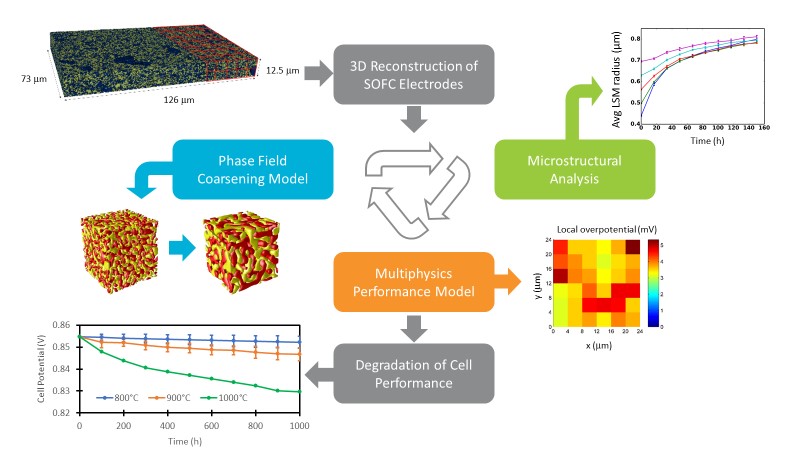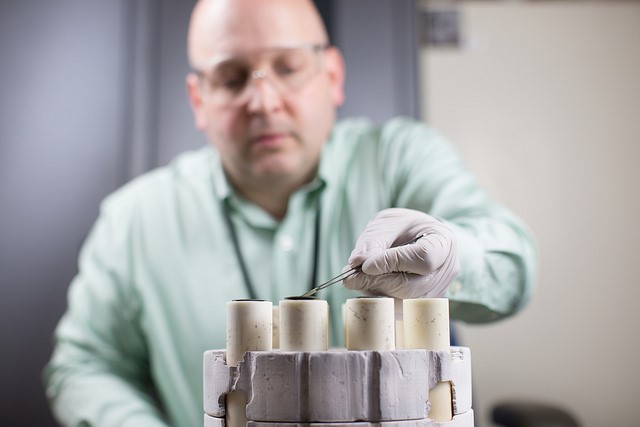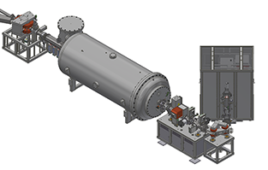
Representation of NETL’s integrated degradation modeling effort. The integrated model combines the experimental, characterization, analytical, and modeling skills of the NETL SOFC research group.
Fuel cells are extremely efficient, require minimal water consumption, and offer a near-zero emission energy generation option. They’re scalable and quiet, making them perfect for integration into large central power plants or local microgrids. Fuel cells can run on hydrogen derived from fossil resources, and their inherent characteristics make them uniquely suited to address the environmental concerns typically associated with fossil-based electric power generation.
Solid oxide fuel cells (SOFCs) are a key technology for the National Energy Technology Laboratory (NETL) one of 17 U.S. Department of Energy national laboratories and the only one dedicated to fossil energy research. NETL’s mission is to discover, integrate, and mature technology solutions to enhance the nation’s energy foundation and protect the environment for future generations. The goal of NETL’s fuel cell research is to enable the highly efficient generation of low-cost electricity and to provide viable technical options enabling carbon capture.
NETL’s research uniquely examines the tightly coupled processes that evolve during cell operations over tens of thousands of hours. NETL researchers are assembling the full breadth of fundamental technical knowledge necessary to examine the coupled degradation phenomena. The information is central to a significant expansion of ceramic engineering competency, and will radically accelerate the time-to-market of the next generation of advanced SOFC materials and structures.
NETL research has a record of success in developing SOFC technology innovations that are approaching commercialization. The story behind that success features cooperation among experts in chemical engineering, materials science, computational methods, analytical sciences, systems engineering, and others to solve the global problem of making fuel cell technology durable and publicly available.

Dr. Harry Abernathy places a button cell on NETL’s multicell array for experimental evaluation.
A global framework of degradation
Despite their many advantages, SOFCs are not yet market ready, and NETL systems analysis experts have identified degradation as a key issue impeding the commercial appeal of SOFCs. Degradation is the departure of any functional SOFC structure from its designed state. The consequences of that degradation limits cells’ operating lifetime and decreases their economic attractiveness.
SOFC and Functional Materials Researcher Dr. Kirk Gerdes explained that, “Degradation is a complex problem that persistently affects cell operation. Complete, fundamental knowledge of the contributing degradation processes and their interrelationship within a complex multi-dimensional operating space is required to rationally engineer materials systems that suppress SOFC degradation to the targeted levels. The global framework NETL is developing not only provides insight into the mechanisms of degradation, it also aids computational efforts to track and predict performance.”
Degradation occurs because SOFC materials and electroceramics composing electrodes and electrolytes are exposed to high-temperature, harsh environments. Additionally, the electroactive regions of the cell feature high-strength electric fields confined to nanometer-wide zones. The combination of thermal, chemical, and electrostatic driving forces within the cell ultimately causes the electrochemical activity of the cell to degrade, reducing efficiency and eventually result in cell failure.
To examine and fully understand how and why degradation occurs, one area of NETL’s SOFC research is focused on developing a global framework by which researchers can track and categorize the degradation process.
The SOFC team’s global framework describes all degradation possibilities, while the team’s research provides real data to populate the framework. The effort supports the commercialization of SOFC technology and facilitates commercial adoption of technical innovations developed through fundamental research.

Dr. William Epting shows a volume element—smaller than the width of a human hair—of an SOFC electrode. Visualizations such as this allow researchers to explore the microstructure interactively and examine where reactions and mechanisms of degradation might be concentrated.
Detailed investigations of SOFC degradation
Investigating degradation to improve the longevity of the fuel cell and ultimately decrease system costs is an integrated effort across NETL and its industry partners incorporating expertise in modeling, analysis, and characterization. NETL researchers team-up with researchers at collaborator universities to experiment with SOFC samples from industrial partners. Then, as technology is developed and matured, it is transferred to those partners for commercial use.
For example, NETL’s microstructural visualization work provides a detailed look at the inner workings of SOFCs. The task begins with use of powerful FIB-SEM equipment that captures cross-section images, which researchers then use to produce high-resolution, three dimensional reconstructions. NETL has created the largest high-resolution electrode reconstructions in the world—some are 100 times larger than any other visualization efforts at the same resolution.
Modeling allows researchers to simulate the SOFC aging process and obtain meaningful results faster and more economically than operating SOFCS for the tens of thousands of hours that would ordinarily be required to run physical experiments. Researchers are able to measure changes and study the effect on cell performance of specific parameters, such as surface area and particle size distributions. Coupled with the information gained from 3D microstructure visualization, researchers can determine what operating conditions and microstructures will be most favorable for a given cell, leading to enhanced engineering of a longer, more efficient cell.
“Using these unique reconstructions together with custom computational codes, we’re able to quantify several structural properties of the porous SOFC electrodes that relate strongly to the fuel cells’ performance. The spatial distribution of these properties across the electrode can then be visualized along with the predicted cell performance to illuminate, for example, trouble spots in the fuel cell. By studying the spatial distribution of these properties across the electrode, and their relationship to performance and degradation, we’re aiming to predict what changes could be made to the materials and manufacturing of fuel cells to improve long-term performance,” explained Post-Doctoral Researcher Dr. William Epting.
SOFC Technical Portfolio Lead Dr. Gregory Hackett emphasized the tangible benefits of this approach. “By garnering a detailed understanding of how changes at the microscale and operating conditions affect the economics of the system at full scale, commercial electricity providers can be confident that they are perpetually producing electricity at the lowest cost possible,” Hackett said.
A complementary modeling effort at NETL examines SOFC properties to determine how the cell itself may be optimized for greater durability. NETL Senior Researcher Dr. Youhai Wen explained that “In this approach, researchers probe how various microstructure attributes affect the microstructural evolution under cell operating conditions and performance degradation of SOFCs using simulated synthetic SOFC microstructure configurations that could not be readily constructed and tested without prohibitively difficult engineering efforts. One of the benefits of this simulation effort is that researchers can postulate what constitutes a perfect fuel cell in terms of performance and durability without costly and timely experimental efforts.”
Electrode innovations for improved SOFC performance
In addition to detailed investigation of fuel cell degradation modes, NETL’s fuel cell researchers have developed new technologies to yield improved performance, increased cell efficiency, and ultimately a diminished system cost. One of these innovations is an award-winning single-step nanofabrication process for infiltrating an electrocatalyst into the porous electrode of the SOFC.
The infiltration method uses a computer model, designed by NETL researchers, that controls the infiltration process and applies materials to the exact location for optimal functionality so that the networks of critical solids and gases interface in a sequential way, improving the fuel cell’s efficiency. Adding the electrocatalyst through infiltration eliminates the structural randomness typically encountered in untreated SOFCs and places the electrocatalyst where it will be most effective, resulting in an engineered structure that offers significantly improved performance.
The manufacturing element of this technique was specifically designed to move infiltrated SOFCs from lab to market: a one-step process that industry could easily adopt to mass produce infiltrated SOFCs. NETL researchers created a refined electrocatalyst with a refined chemical composition for more uniform deposition and a sonic spray coating device to automatically deposit the materials during manufacturing, thereby avoiding multiple heat-treatment steps required by previous methods to deliver an adequate amount of catalyst.
Materials scientist Dr. Shiwoo Lee, who invented the novel process, says it holds great potential for further development. “What is especially exciting about this technique is that it offers very precise control for nanostructure optimization. Process customization for any industry SOFC is possible, and we can expect the technique to be extended to additional applications and more sophisticated structures through three-dimensional nanostructuring,” Lee said.
Full-scale testing by industry partners demonstrated that the materials and nanostructure resulting from this fabrication process are more advanced than traditional electrodes, have increased power density, reduced electrode degradation, and doubled cell lifetime. The method was the subject of a recent patent application, and promises to both greatly improve current processes and eventually lead to commercial-scale manufacturing of advanced SOFC (electrodes).
As work continues, NETL’s research is driven by the overarching goal of accelerated deployment of transformational clean energy technology. With a better understanding of how degradation occurs and the factors influencing an SOFC’s durability, researchers can engineer approaches and tools for minimizing degradation for specific conditions. This means more durable SOFCs that will last longer and function better to become an attractive coal-based option for utility-scale power generation.




